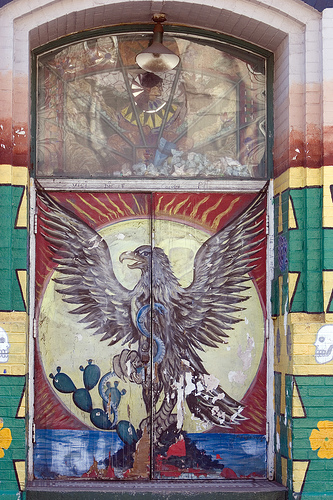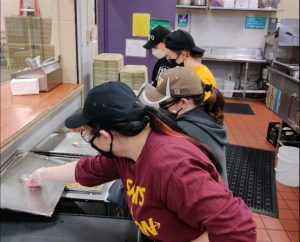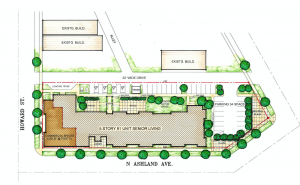In the 1990s, Pilsen was known as a neighborhood not safe to walk through at night, highlighted by the Illinois Criminal Justice Information Authority naming it a hot spot for gang violence in 1992. Now, just 20 years later, Pilsen is known as a trendy neighborhood, that residents say has been completely redefined by gentrification.
John Betancur, an associate professor of urban planning and policy at the University of Illinois at Chicago, said Pilsen has been gentrifying thanks to the help of the City of Chicago, which has worked to encourage higher income residents to move into the neighborhood, located just southwest of the loop.
Many in the neighborhood are resistant to the changes, and feel they are being driven out of their homes, while others, like Jess Saldanda, 21, point to the area’s gentrification as the reason crime has dropped in Pilsen.
“With all the artists moving in and all the apartments being taken up by the non-violent people, it has saturated the neighborhood and made it this mixture of families who’ve lived here for generations and a mixture of students,” said Saldanda, who has lived in Pilsen for the past two years.
Saldana moved to Pilsen because of its close proximity to Columbia College Chicago, and because it offers cheap rent.
Gentrification, like the type that has been going on in Pilsen, occurs when upper- or middle class residents move into low-income neighborhoods, raising property values and displacing residents and local businesses.
Gustavo Sanchez, 44, a resident of Pilsen for 30 years is one of many Mexican residents in the neighborhood affected by gentrification.
“All my life since I was 10 years old, I’ve been living in Pilsen and I have seen the changes of the community in general, and it has personally affected me in many ways; like displacement of our friends and family because they had to move because they couldn’t afford their rents,” Sanchez said.
Roxana Aguilar, 34, a Pilsen resident since 1998, has also seen a change within the neighborhood.
“The community themselves don’t know they’re being displaced, they don’t know that its gentrification. They just know the rent is going high, their taxes are going up and they just need to move out,” Aguilar said.
Aguilar, is one of many residents in the community who has been displaced due to gentrification.
“I’m upset that people that took the decision to displace the community and did not inform [us] what they’re trying to do. They basically did it slowly and did not give the community a chance to relocate somewhere. They don’t care about your children, they don’t care about our health, and we’re just nobodies,” Aguilar said.
Gentrification has slowly been making its way in Pilsen for more than 20 years.It may have began with the Podmajersky family in the ’90s, when they purchased properties on the east side of Pilsen and renovated them. The cheap rent began attracting artists, eventually, Podmajersky INC had created a 250,000-square-foot art colony featuring offices and commercial and retail spaces.
“Young people gravitate towards art, they gravitate towards culture. When the artists came, young people came, and then the gentrification came,” Saldana said.
But Betancur said the change has not come without considerably help from the city government.
“Unleashed by the City of Chicago‘s repeated plans for upgrading and turning of the neighborhood over to higher income households and users; [gentrification’s] first significant expression was the development of an arts cluster in the east end of the neighborhood that progressively expanded eventually attracting other gentrifiers but most particularly developers. All these actions created major expectations bringing property values up throughout the entire community. ,” said Betancur.
And that change has had a drastic effect on Pilsen’s demographics.
In 1990 according to the U.S. Census Bureau, the Hispanic population in Pilsen was at 88 percent, while whites accounted for just three percent of the population. In 2000 the Hispanic population increased to 90 percent, while the white population rose to eight percent. Just 10 years later, the Hispanic population has gone down to 78 percent, while the white percentage has gone up to 28 percent, a 20 percent increase from 2000.
The sudden surge in white residents, up more than 900 percent in two decades, has caused some strain between the neighborhood’s new and existing residents.
“There was this poster that said Gringos get out of here, get your hipster crap out of here, you’re displacing working class families. My response was, ‘the only thing that got displaced when I moved to Pilsen was my boyfriends Adidas collection,’” said Camela Christoper, 34, a resident of Pilsen for 11 months.

Steven Lieto, 30, who has been a resident of Pilsen for four years has also dealt with some negative reactions from residents.
“I’m totally a yuppie and I’ve been in the neighborhood for four years and there are peripheral things that I soak up, like the ‘yuppies out of Pilsen’ stickers with graffiti on the ground,” Lieto said.
Francisco Rico, 34, who has been a resident of Pilsen his whole life, is one of the few residents who welcomes the change. “[Gentrification] is part of Pilsen, it’s good for the neighborhood. When we were growing up we didn’t have as many stores or anything around here [and] it was a bad neighborhood,” Rico said.
With gentrification making way in Pilsen, many residents fear there is no turning back, and like it or not, Betancur said without drastic changes throughout the city, the changes are here to stay.
“For gentrification to be tamed or controlled, the entire tax and opportunity structure would have to be changed, by assessing taxes on the basis of the income of residents, by taxing capital gains at 100 percent, by ending the corruption of politicians who ‘cut deals’ with developers to beef up their electoral coffers and get re-elected. And by changing the city’s real estate priorities,” said Betancur.
Without those steps, 30-year resident Sanchez said he is doing the next best thing, embracing the changes.
“I believe in change, I am pro-change and I believe that whether we like it or not, things are going to change like when this community was populated by Czechoslovakians and Italians and other ethnic groups, and they moved and the Latino community moved in, and you can say that was like a gentrification but it was just a change,” Sanchez said.
Related articles
 Pilsen: Neighborhood Home to ‘Greenest Street in America’(chicagotalks.org)
Pilsen: Neighborhood Home to ‘Greenest Street in America’(chicagotalks.org)


















Be First to Comment